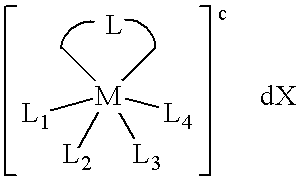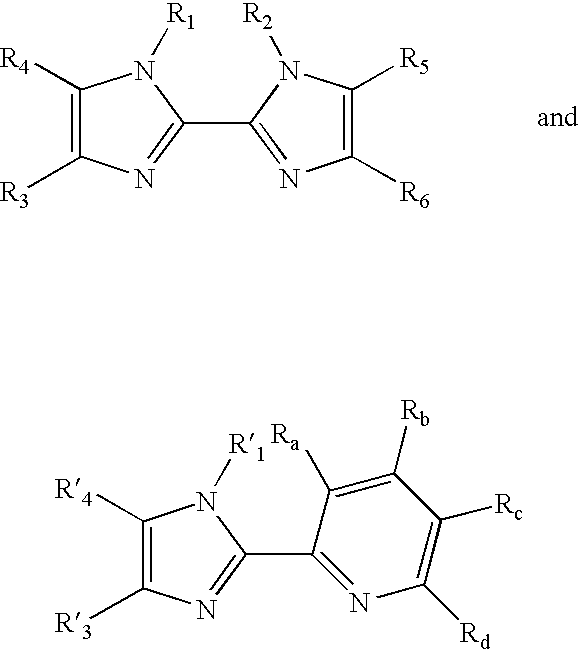Transition metal complexes with bidentate ligand having an imidazole ring
- Summary
- Abstract
- Description
- Claims
- Application Information
AI Technical Summary
Benefits of technology
Problems solved by technology
Method used
Image
Examples
example 1
Synthesis of 4-(5-carboxypentyl)amino-2,2′-bipyridyl
[0104]This example illustrates how a carboxy reactive group is introduced onto a 2.2′-bipyridyl derivative.
Synthesis of compound D: To compound C (formed from A and B according to
[0105]
Wenkert, D.; Woodward, R. B. J. Org. chem. 48, 283(1983)) (5 g) dissolved in 30 mL acetic acid in a 100 ml round bottom flask was added 16 mL acetyl bromide. The yellow mixture was refluxed for 1.5 h and then rotovaporated to dryness. The resulting light yellow solid of D was sufficiently pure enough for the next step without further purification. Yield: 95%
[0106]Synthesis of compound E: To a stirred suspension of compound D in 60 mL CHCl3 was added 12 mL PCl3 at room temperature. The mixture was refluxed for 2 h under N2 and then cooled to room temperature. The reaction mixture was poured into 100 mL ice / water. The aqueous layer was separated and saved. The CHCl3 layer was extracted three times with H2O (3×60 mL) and then discarded. The combined aqu...
example 3
Synthesis of 1,1′-dimethyl-2,2′-biimidazole
[0113]This example illustrates the synthesis of 2,2′-biimidazole derivatives.
[0114]
[0115]The alkylation step can be carried out stepwise so two different alkyl groups can be introduced. For example:
[0116]
[0117]Synthesis of compound K: To a stirred solution of compound J (formed from I according to Fieselmann, B. F., et al. Inorg. Chem. 17, 2078(1978)) (4.6g, 34.3 mmoles) in 100 mL dry DMF in a 250 ml round bottom flask cooled in an ice / water bath was added in portions NaH(60% in mineral oil, 2.7 g, 68.6 mmoles). After the solution was stirred at 0° C. for one more hour under N2, methyl toluenesulfonate (10.3 mL, 68.6 mmoles) was added in small portions using a syringe over 30 min. The stirring of the solution in the ice / water bath was continued for 1 h and then at room temperature for 3 h. The solvent was removed by vacuum distillation. The dark residue was triturated with ether and then suction filtered and dried under vacuum. The product ...
example 4
Synthesis of 2-(2-Pyridyl)imidazole Heterobidentate Ligands
[0121]This example illustrates a general synthesis of heterobidentate ligands containing an imidazole ring.
[0122]
[0123]Synthesis of compound O: A solution of 6-methylpyridine-2-carboxaldehyde (26 g, 0.21 mole) and glyoxal (40% , 30 mL) in 50 mL EtOH in a three-necked 250 mL round bottom flask fitted with a thermometer and an addition funnel was stirred in a NaCi / ice bath. When the solution was cooled to below 5° C., conc. NH4OH was added dropwise through the addition funnel. The rate of the addition was controlled so that the temperature of the solution was maintained at below 5° C. After the addition, the stirring of the yellow solution was continued in the ice bath for 1 h and then at room temperature overnight. The light yellow crystals were collected by suction filtration and washed with H2O (20 mL). The crystals were resuspended in H2O (200 mL) and boiled briefly, followed by suction filtration, to collect the product w...
PUM
| Property | Measurement | Unit |
|---|---|---|
| Mass | aaaaa | aaaaa |
| Electric potential / voltage | aaaaa | aaaaa |
| Molecular weight | aaaaa | aaaaa |
Abstract
Description
Claims
Application Information
 Login to View More
Login to View More - R&D
- Intellectual Property
- Life Sciences
- Materials
- Tech Scout
- Unparalleled Data Quality
- Higher Quality Content
- 60% Fewer Hallucinations
Browse by: Latest US Patents, China's latest patents, Technical Efficacy Thesaurus, Application Domain, Technology Topic, Popular Technical Reports.
© 2025 PatSnap. All rights reserved.Legal|Privacy policy|Modern Slavery Act Transparency Statement|Sitemap|About US| Contact US: help@patsnap.com



